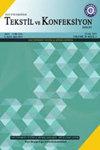Effect of UV Exposure on the Mechanical Properties of Polyurethane-Coated Fabrics
IF 0.7
4区 工程技术
Q4 MATERIALS SCIENCE, TEXTILES
引用次数: 0
Abstract
Polyurethane materials can be used industrially in different ways, some of which can be used as textile materials or as auxiliary materials applied to textile materials. Polyurethane stands out as a widely used polymer for coating textile products used in outdoor applications, because of high stability at low temperature, flexibility, no or very little volatile organic component content, high water resistance, pH stability, excellent solvent resistance, weather resistance, and many other chemical and mechanical properties. In the study, cotton, polyester, and viscose fabrics were coated with polyurethane and aged under UV light to investigate the causes and behaviors of the mechanical degradation effects of UV on the coating material and fiber. The results indicate that the PU coating process improves the mechanical properties of textile materials while being exposed to UV rays deteriorates the fabric structure. The deterioration in the structure of raw and coated fabrics with the effect of UV increased the air permeability. According to the results of DSC analysis, the increase in the time of UV exposure did not create significant differences in terms of thermal degradation temperatures in both cotton and viscose fabrics. The glass transition temperatures (Tg) increase with more exposure to UV rays, and the UV exposure time had a negative effect on the melting temperature (Tm) and enthalpy (ΔH) of coated polyester fabrics.紫外线照射对聚氨酯涂层织物力学性能的影响
聚氨酯材料在工业上有不同的用途,其中一些可以作为纺织材料或作为纺织材料的辅助材料。聚氨酯因其在低温下的高稳定性、柔韧性、无或很少挥发性有机成分含量、高耐水性、pH稳定性、优异的耐溶剂性、耐候性以及许多其他化学和机械性能而被广泛应用于户外应用的涂料纺织产品。通过对棉、涤纶、粘胶织物进行聚氨酯涂层,并在紫外光下进行老化,研究紫外光对涂层材料和纤维的机械降解作用的原因和行为。结果表明,聚氨酯涂层工艺改善了纺织材料的力学性能,但暴露在紫外线下会使织物结构恶化。紫外线的作用使原织物和涂层织物的结构恶化,使其透气性增加。根据DSC分析的结果,紫外线照射时间的增加并没有造成棉和粘胶织物热降解温度的显著差异。随着紫外线照射时间的增加,涂层聚酯织物的玻璃化转变温度(Tg)升高,紫外线照射时间对涂层聚酯织物的熔化温度(Tm)和热焓(ΔH)有负向影响。
本文章由计算机程序翻译,如有差异,请以英文原文为准。
求助全文
约1分钟内获得全文
求助全文
来源期刊

Tekstil Ve Konfeksiyon
工程技术-材料科学:纺织
CiteScore
1.40
自引率
33.30%
发文量
41
审稿时长
>12 weeks
期刊介绍:
Tekstil ve Konfeksiyon, publishes papers on both fundamental and applied research in various branches of apparel and textile technology and allied areas such as production and properties of natural and synthetic fibers, yarns and fabrics, technical textiles, finishing applications, garment technology, analysis, testing, and quality control.
 求助内容:
求助内容: 应助结果提醒方式:
应助结果提醒方式:


